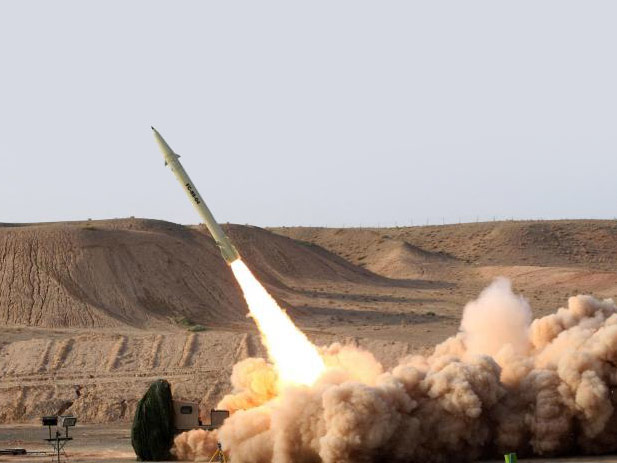
Israel fears Hezbollah has killer SAMs

As the Middle East frets about a regional conflict, Israel's military says it believes Lebanon's Iranian-backed Hezbollah has long-range surface-to-air missiles supplied by Syria, significantly boosting its defenses against the Jewish state's formidable air power.
The Jerusalem Post reported Thursday that the military command "is also working under the assumption" that the Lebanese movement, which fought Israel's armed forces to a standstill in 2006, has obtained several dozen long-range M600 surface-to-surface missiles from Syria, Iran's ally.
Hezbollah is already believed to have a substantial number of M600s, which are Syrian-produced clones of Iran's Fateh-100 missile.
The M600 has a range of around 190 miles and carries a warhead containing a half-ton of high explosives.
The Israelis estimate that Hezbollah possesses around 42,000 missiles and rockets, including long-range weapons capable of hitting anywhere in Israel and which are changing the nature of Middle Eastern warfare.
That's more than three times the number of missiles Hezbollah had at the outset of the 34-day war in July-August 2006. Hezbollah fired nearly 4,000 rockets and missiles, or around 200 a day, into Israel's northern Galilee region during that conflict.
That was the heaviest bombardment Israel's civilian population endured since the state was founded in 1948 but that pales against the threat the nation faces from the missile arsenals of Iran, Syria, Hezbollah and the Palestinian radical of Hamas in the Gaza Strip.
Military officials have warned Israel's population of 7 million that Israeli cities could be hit by 500 projectiles a day for weeks on end if a new conflict erupts.
"According to Western intelligence assessments, Hezbollah is believed to have taken advantage of the ongoing upheaval in Syria to obtain advanced weapons systems, such as additional long-range rockets as well as Russian-made air-defense systems," Post military analyst Yaacov Katz wrote.
The Israelis said Shiite guerrillas, who have underground missile depots across their heartland in the Bekaa Valley of northeastern Lebanon along the Syrian border, possess the SA-8, a Russian mobile SAM system with an estimated range of around 20 miles.
The Israeli air force, the strongest in the Middle East and equipped largely with U.S.-made aircraft and weapons systems, is capable of countering the SA-8 with electronic jamming systems and precision-guided munitions.
It displayed these capabilities Sept. 6, 2007, when seven F-15I Raam fighters destroyed a suspected nuclear reactor being built by North Korea in Syria at Deir al-Zor 80 miles from the Iraqi border.
The warplanes in Operation Orchard were able to evade Syrian air defenses during the night-time raid because an electronic warfare aircraft accompanying them blinded Syrian radars and missiles defenses.
However, if Hezbollah has SA-8s in sufficient numbers to hurl multiple missiles at Israeli aircraft, which have enjoyed unchallenged mastery of the skies over Lebanon for decades, it could impede airstrikes.
These are likely to be aimed at Hezbollah's missile storage sites and launch sites. In the first 36 hours of the 2006 war, Israeli warplanes destroyed most of Hezbollah's long-range missiles before they could be used.
That saved Israel from far greater damage during the fighting.
With enough SA-8s, and the large quantity of Russian shoulder-fired SAMs Hezbollah is believed to have received from Syria over the last two years, the battle-hardened guerrillas could blunt Israeli air operations for a time to a degree not seen since the invading Egyptians drove off Israeli jets in the opening days of the 1973 war.
Apart from the addition of "several dozen" M600s to its armory, Hezbollah is believed to have acquired additional 302mm Khaibar-1 rockets from Syria. These have a range of around 62 miles.
The Israelis' big fear is that the Damascus regime, battling against a stubborn 10-month-old pro-democracy uprising aimed at toppling President Bashar al-Assad, will transfer advanced weapons systems, including chemical weapons, to Hezbollah if it looks like the opposition is going to win.
In the meantime, Syria has been acquiring new systems from Russia, a key backer of Assad's regime.
In December, the Russian Interfax news agency, quoting military sources in Moscow, said Russia had delivered supersonic Yakhont SS-N-26 anti-ship cruise missiles to Damascus despite calls for a U.N. arms embargo on Assad's regime.
The 2007 contract, worth an estimated $300 million, reportedly involved at least two coastal-defense Bastion anti-ship systems with 72 Yakhonts.
Source: Tel Aviv, Israel, 19 January 2012 - United Press International / Special Reports (www.upi.com)
Photo: An upgraded version of the short-range surface-to-surface Fateh-110 missile is test fired on August 25, 2010, in this photo released by the Iranian Defense Ministry. (Photo by UPI/Vahid Reza Alaei/ Iranian Defense Ministry)
(19.01.2012)
|